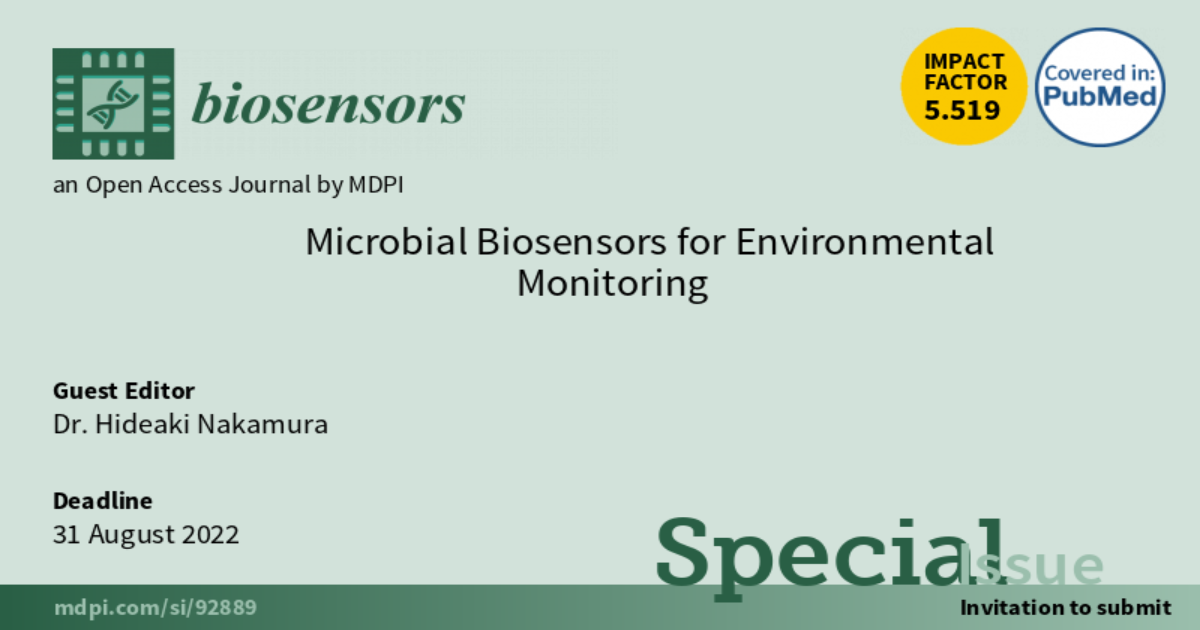Microbial Biosensors for Environmental Monitoring
A special issue of Biosensors (ISSN 2079-6374). This special issue belongs to the section "Biosensor and Bioelectronic Devices".
Deadline for manuscript submissions: closed (31 August 2022) | Viewed by 16089

Special Issue Editor
Interests: microbial biosensors; yeast; BOD; toxicuty; soil; mediator
Special Issues, Collections and Topics in MDPI journals
Special Issue Information
Dear Colleagues,
The microbial biosensor makes it possible to measure the analyte as a quick, simple, and convenient method. Since Dr. Isao Karube (1942–2020) succeeded in the practical use of the first microbial biosensor for biochemical oxygen demand monitoring in 1983, many kinds of microbial biosensors for environmental monitoring have been studied and developed. To date, various improvements have been made to microbial biosensors in terms of, e.g., sensitivity, reproducibility, stability, specificity, and portability. Especially in the last decade, new and improved techniques have successfully been applied to microbial biosensor developments such as 3D printing for chip/cell/array or device fabrication, genetic engineering for microbial modification, materials science for microbial immobilization or signal detection, new techniques for transducer development, etc.
On the other hand, the global environment is becoming worse year by year, including climate change due to global warming. If we want humanity to survive, we have an obligation to transform our world—which is why in 2015, the United Nations Sustainable Development Summit adopted “The 2030 Agenda” and “The Sustainable Development Goals (SDGs)”. In this agenda, there are several goals that microbial biosensors are able to contribute to achieving, such as “conservation of water and soil resources”, “preservation of food safety”, etc. Thus, the scope of this Special Issue includes the topics listed below:
- Application to environmental water or wastewater monitoring;
- Application to estimate soil environment or bioremediation;
- Application to agriculture, aquafarming, or aquaponics;
- Micro/nanotechnology and novel materials applied to microbial biosensors;
- Novel designs of chip/cell/array for microbial biosensors;
- Novel instrumentation systems for microbial biosensors;
- New solutions applied in microbial biosensors;
- Interdisciplinary study leading to microbial biosensor development.
This Special Issue aims to highlight the most recent advances of microbial biosensors and participate in the development of microbial biosensors for SDGs efforts toward 2030. Research papers, short communications, and critical reviews are all welcome. If the author is interested in submitting a critical review, it would be helpful to discuss this with the Guest Editor before your submission.
Dr. Hideaki Nakamura
Guest Editor
Manuscript Submission Information
Manuscripts should be submitted online at www.mdpi.com by registering and logging in to this website. Once you are registered, click here to go to the submission form. Manuscripts can be submitted until the deadline. All submissions that pass pre-check are peer-reviewed. Accepted papers will be published continuously in the journal (as soon as accepted) and will be listed together on the special issue website. Research articles, review articles as well as short communications are invited. For planned papers, a title and short abstract (about 100 words) can be sent to the Editorial Office for announcement on this website.
Submitted manuscripts should not have been published previously, nor be under consideration for publication elsewhere (except conference proceedings papers). All manuscripts are thoroughly refereed through a single-blind peer-review process. A guide for authors and other relevant information for submission of manuscripts is available on the Instructions for Authors page. Biosensors is an international peer-reviewed open access monthly journal published by MDPI.
Please visit the Instructions for Authors page before submitting a manuscript. The Article Processing Charge (APC) for publication in this open access journal is 2700 CHF (Swiss Francs). Submitted papers should be well formatted and use good English. Authors may use MDPI's English editing service prior to publication or during author revisions.
Keywords
- microbial biosensor
- microbial fuel cell
- environmental monitoring
- field analytical devices
- on-site
- wastewater
- soil
- biochemical oxygen demand (BOD)
- toxicity
- heavy metal
- mediator
- biochip
- sustainable
Benefits of Publishing in a Special Issue
- Ease of navigation: Grouping papers by topic helps scholars navigate broad scope journals more efficiently.
- Greater discoverability: Special Issues support the reach and impact of scientific research. Articles in Special Issues are more discoverable and cited more frequently.
- Expansion of research network: Special Issues facilitate connections among authors, fostering scientific collaborations.
- External promotion: Articles in Special Issues are often promoted through the journal's social media, increasing their visibility.
- e-Book format: Special Issues with more than 10 articles can be published as dedicated e-books, ensuring wide and rapid dissemination.
Further information on MDPI's Special Issue polices can be found here.






